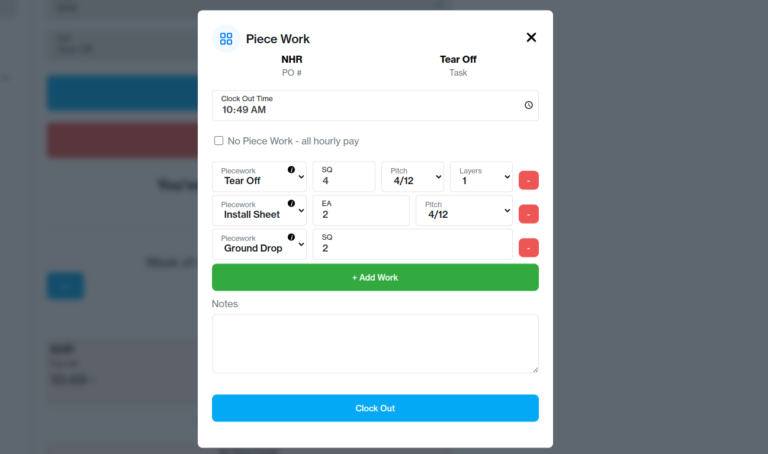How to Transition from Hourly to Piece Work Pay Without Chaos
Switching how you pay your employees—from hourly wages to piece work pay—can feel like a big leap. Business owners in industries like manufacturing, agriculture, or construction often wrestle with payroll headaches or worry about keeping workers happy while trying to increase output. A piece work system, where pay is based on the amount of work completed (like $30 per square in roofing), can drive efficiency, but without a clear plan, it risks chaos—think upset employees, legal slip-ups, or sloppy tracking. This article walks you through a smooth transition step-by-step, covering benefits, pitfalls, and practical solutions to make it work for your team.
In This Guide
- What Is Piece Work Pay and Why Switch?
- Key Benefits of Moving to Piece Work Pay
- Challenges You Might Face During the Transition
- Legal Rules to Follow for a Compliant Switch
- Step-by-Step Guide to Transition Without Chaos
- Conclusion: Make the Switch Work for You
What Is Piece Work Pay and Why Switch?
Piece work pay means employees earn based on how much they produce, not how many hours they clock. For example, in roofing, a worker might make $30 per square completed, which takes about an hour. Compare that to a flat $30/hour wage—piece work ties pay directly to output, not time. Companies switch to this system to boost productivity, cut labor costs, and give workers more control over their earnings. It’s popular in construction, manufacturing (think parts assembled), agriculture (like baskets picked), and even freelance gigs (articles written). But moving from hourly to piece work isn’t just a flip of a switch—it needs planning to avoid confusion.
Key Benefits of Moving to Piece Work Pay
Why make the change? Here’s what you gain:
- Higher Productivity: Workers push harder when pay reflects their effort. If a square takes an hour, a fast worker finishing two earns $60 instead of $30.
- Lower Costs: You pay for results, not idle time. This helps predict labor expenses better.
- Worker Flexibility: Employees can adjust their pace to hit income goals, appealing to self-driven people.
- Simpler Forecasting: Knowing each square costs $30 makes budgeting easier than guessing hourly output.
Challenges You Might Face During the Transition
Switching isn’t all smooth sailing. Here are common hurdles:
- Employee Pushback: Hourly workers might fear unsteady pay if output varies, or that you’re just trying to get more out of them for less.
- Tracking Trouble: Counting squares or units manually can lead to errors or arguments.
- Quality Risks: Workers might rush, skimping on quality to earn more.
- Payroll Complexity: Ensuring minimum wage (like $7.25/hour federally) and overtime can add math headaches.
Legal Rules to Follow for a Compliant Switch
The law doesn’t bend for piece work. Here’s what to know:
- Minimum Wage: The Fair Labor Standards Act (FLSA) says piece workers must average at least minimum wage in your area. If someone earns $60 for two squares in three hours, that’s $20/hour—safe. But $30 for one square in two hours is $15/hour—still good, but track it.
- Overtime: Over 40 hours a week, pay 1.5 times the regular rate. This must be taken into account for calculating average earnings in a week w/ minimum wage.
- Recordkeeping: Log hours and output. Track everything. Mistakes here can mean fines or upset employees.
This is not legal advice though – please double check with your local authorities to make sure you’re following the law.
Step-by-Step Guide to Transition Without Chaos
Ready to switch? Follow these steps:
Step 1: Analyze Your Current System
Look at your hourly setup. If workers earn $30/hour and finish one square per hour, piece work at $30/square matches that. Test output over a week—does it vary? This sets your baseline.
Step 2: Set Fair Piece Rates
Pick a rate that’s fair but profitable. At $30/square, workers match hourly earnings for average effort. Too low ($20/square), and they’ll grumble; too high ($40/square), and costs balloon. Test it with a small group first.
Step 3: Talk to Your Team
Explain the change clearly. Say, “You’ll earn $30 per square instead of $30/hour—work faster, earn more.” Address fears: “Even slow days won’t dip below minimum wage.” Get buy-in early.
Step 4: Try a Hybrid Approach
Ease in with a mix: $15/hour base plus $15/square. It softens the shift, keeping pay steady (around $30/hour for one square) while rewarding output. Workers feel secure, and you test the waters.
Step 5: Simplify Tracking and Payroll
Manual logs waste time and spark disputes. Use a tool to automate piece rate tracking—count squares, calculate pay, and ensure compliance in minutes. Software cuts errors compared to spreadsheets or paper.
Step 6: Monitor Quality and Adjust
Set clear standards (e.g., “Squares must pass inspection”). Check work weekly. If quality slips, tweak rates or add bonuses for perfection. Avoid the “ratchet effect”—don’t hike quotas after workers speed up, or trust erodes.
Step 7: Train and Launch
Train supervisors on tracking and payroll. Run a pilot for a month, then roll out fully. Keep communication open—fix issues fast.
Conclusion: Make the Switch Work for You
Transitioning from hourly to piece work pay can transform your business, driving output and slashing costs. But success hinges on preparation: set fair rates, follow legal rules, and track output accurately. A hybrid system or smart tools can ease the shift, keeping workers happy and payroll simple. Evaluate your current setup—could piece work boost your bottom line? With the right plan, you’ll avoid chaos and unlock efficiency. Explore solutions that streamline the process, and watch your team thrive.



